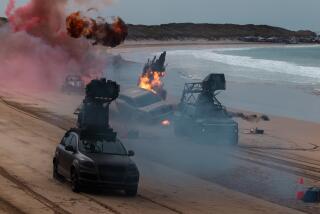Buffs Gather to Celebrate : Skeleton Run at St. Moritz Called Most Thrilling Sled Ride in World
- Share via
ST. MORITZ, Switzerland — Prone on a narrow steel sled they go, head first, eyes only four inches above the ice, reaching speeds of up to 87 m.p.h. in what the riders rate as the most thrilling sled run in the world.
Every day during the winter, hundreds of riders from teens to senior citizens take up the unique challenge and ride the cresta, three-quarters of a mile of solid ice first built 100 years ago in this resort.
“Skeleton” buffs, as the riders are known, came from all over the world last week to celebrate the anniversary of the hair-raising spectacle, an outgrowth of the toboggan racing that was born earlier last century in the Swiss Alps.
The sport was founded by a group of patients who had come from England to Switzerland in search of relief from asthma and other ailments. Converting pastime to sports, they thus made other Europeans convinced “that the British are raving mad,” as Prince Philip of Britain put it in a foreword to a book on the cresta’s history.
The madness has long crossed borders and the British-born St.Moritz Tobogganing Club now includes members from 20 other nations, practicing a sport that inspired Scottish author Robert Louis Stevenson to speak of “a new excitement to the life of man upon this planet.” At that time, cresta riders could boast of being the world’s fastest humans.
Americans have a particular part in the cresta history, with brothers Jennison and Jack Heaton winning gold and silver when skeleton races were added to the Olympic schedule in 1924 at the St. Moritz Winter Games.
The plus fours and woolen caps of pre-World War I times have given way to brightly colored wet suits and crash helmets, but the basic design of the skeleton has hardly changed and the challenge has remained the same. Without brakes or steering mechanism, the steel sleds are chiefly controlled by the rider shifting his position.
“It is just an indescribable feeling,” Lt. Col. D.J. Willoughby, the tobaggoning club’s secretary, said. “I suppose it’s the feeling of enjoyment of actually riding the cresta from the top and the relief of reaching the finish.”
“You get very much addicted to it,” continued Willoughby, the one-time commander of a Gurkha regiment and a cresta addict since 1958. “Once one has been down there, it is always a challenge to beat one’s own time.”
The run record stands at 51.75 seconds, set in 1984. But the uncrowned king of the cresta is Nino Bibbia, who runs a grocery store in St. Moritz and was Olympic champion in 1948, the last year skeleton races figured in the Winter Games. Cresta is an Olympic sport only when the Winter Games are held here.
The 68-year-old Italian-born Bibbia, who is still active, knows every inch on the course, having ridden it thousands of times and won more than 220 races. But many go down for the sheer fun of it rather than to win or to set records.
“Some have skated down it, ridden it barefoot and in one case even been down it naked,” recalls a brochure published for the Feb. 2-10 centenary celebrations.
Links to the cresta can last for life. Lawrence Ames, a retired U.S. Army major general, rode the run to mark his 80th birthday. A one-time club president, Lord Brabazon of Tara, rode down to celebrate his 79th birthday.
Newcomers to the run are soon likely to become members of the “Shuttlecock Club,” named after the most difficult of the run’s 10 turns. Membership is automatic for every rider who has at least once been thrown into the snow and hay piled up for protection on the turn.
“I believe there are one or two who have never fallen at the Shuttlecock,” Willoughby said. “But most of us have fallen many, many times.
“This season, we had about 4,700 rides so far and 347 falls, mostly at Shuttlecock. The ratio is about one fall in 14 rides.”
Serious spills are rare and the latest fatal accident dates to 1973, he said.
“We all get bruised, that’s natural,” the 50-year-old Willoughby said. “My thighs are all bruised after three rides yesterday. We have some broken hands or broken arms each season but not many. They are the exception rather than the rule. But the record will show that we had less accidents on the cresta than in crossing the streets in St. Moritz.”


